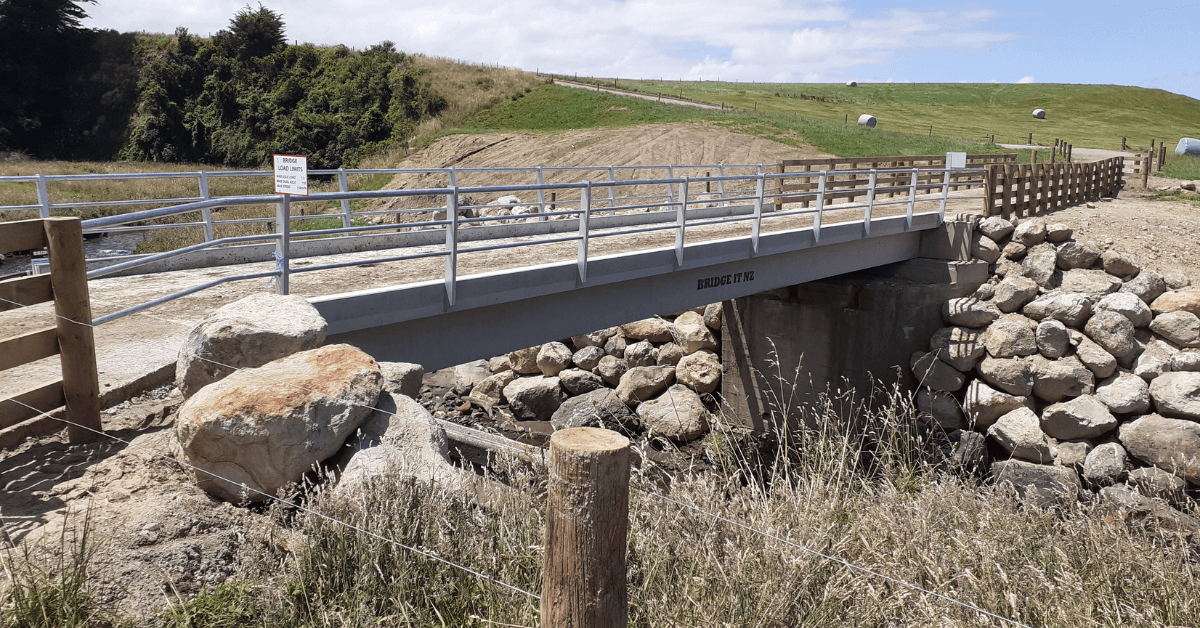Bridge Insurance: What You Need To Know

Bridges are a big capital investment so it’s important to insure them. One big earthquake, storm event or an inattentive driver can cause some serious damage! In this article we’ll share everything you need to know about bridge insurance to make sure you’re covered.
Many people assume their bridge will be automatically included in their house policy or commercial business insurance but that’s not always the case. It’s vital to check with your insurance company if your bridge is insured, and how much it is insured for.
Often your bridge (or certain components like retaining walls) may have a maximum dollar limit or only be insured for its indemnity value (i.e. its current value allowing for its age and condition immediately prior to damage). This can be well short of the amount you need to actually repair or replace your bridge and you could find yourself hundreds of thousands of dollars out of pocket.
Where To Look
Check your house policy or your material damage policy if you’re a commercial business. Look at the definition and wording to see if your bridge is covered or potentially excluded. Commercial businesses should check:
- If you have adequate bridge insurance cover for the bridge itself
- What extra operating costs or business interruption costs could arise if your bridge is out of action?
- What other costs might you incur if you lose access to your bridge?
- Does your insurance policy cover all these scenarios?
Who To Call
Call your insurer and talk specifics. If your bridge is excluded, you can usually negotiate to have it included on your certificate of insurance as a ‘specified item’ for an additional fee. Be transparent and provide as much detail as possible so they can accurately calculate a replacement cost or indemnity value and set a premium for you.
If you need help with estimating costs, get in touch and we can assist.
Check whether your retaining structures or scour protection (such as rip rap wrap or gabion baskets) are covered. Some insurers will cover your physical bridge structure (the deck, abutments, piers etc) but not these other elements. Is the approach to your bridge covered by your insurer? In a major flood, the approaches either side of your bridge may be damaged as well and need replacing.
The most common bridge insurance claims are for flood damage and vehicle damage.
If bad weather is forecast, clear away any debris that might be caught up around your bridge and impede the flow of water before heavy rain arrives. As a reasonable policyholder, you can show you’re taking steps to mitigate potential loss to your bridge.
In the case of vehicle accidents, signage is important. Think about installing appropriate signage to show what the safe width of the bridge is, what the safe vehicle axel load is, and if it’s a bridge where vehicles pass underneath, what the height of the bridge is so drivers know what the safe limits are.
Maintenance is another key factor. Regularly look for signs of erosion or dilapidation on your bridge and take steps to repair it. Maintenance can have quite a bearing with certain insurers at claim time as to whether they accept your claim or not. If they have good grounds to demonstrate you haven’t been maintaining your bridge, they could decline your cover.
Bridge It NZ can help you with this – call us today and we’ll provide a quote to inspect your bridge and recommend what maintenance is required.
Normally an insurance claims assessor will visit to assess the damage (even if your bridge has been carried downstream) and look at the width of the crossing the bridge provided, and what the construction materials were.
To determine a present day value, they will consider how the bridge was built, what it was made of, and how old it was at the time of loss. Materials will be depreciated based upon their likely life expectancy. A steel and concrete bridge will have a greater life expectancy than a timber bridge so that is a factor to consider when building your bridge in the first place.
What About EQC – Will They Provide Cover?
Your bridge insurance payout may also be effected by any EQC payout. EQC provides cover in the event of natural disasters for bridges and culverts that are situated within your land holding and are within 8m of your home or within 60m of your home and constitutes your main access way.
They also cover retaining walls and their support systems that are necessary for the support or protection of your home or insured land (including the main access way) if they are within 60m of your home.
EQC calculate their payout on either the cost of repair of the damaged land structures, or their indemnity value, depending on the damage to the whole area of insured land. Again, this indemnity value might be substantially less than the cost of building a new bridge – so your private insurer will then top up the difference depending on what cover you have arranged with them. If you have full replacement cover, you will be sorted.
Bridges can be worth hundreds of thousands of dollars. If your insurer is only offering a limit of $30,000, you might want to get your bridge specified on your policy and pay an additional premium for that peace of mind in worst case scenarios. Think about what impact any loss or damage could have to your daily life or business.
Remember, be upfront with your insurance company at the beginning. As with all insurance, it’s about being as transparent as possible when applying for cover. Give as much information as you can and arrange as much cover as you can afford.
The information contained in this article was sourced from an independent insurance assessor in May 2022. It does not constitute formal insurance or financial advice.

